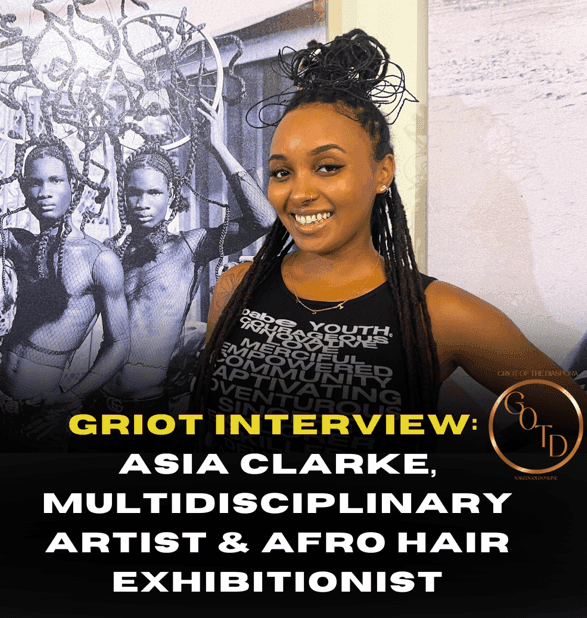Asia Clarke is one of the African diaspora's preservationist in art and Afro hair. African, Afro, Black and Indigenous hair is in a battle for acceptance in Westernized spaces, but Asia Clarke artistically creates Afro hair art that provokes emotions for all to view. Hair is often viewed as art or fashion, but in Black bodies hair becomes political. The texture of Black hair in metropolitan, city or industrial environments evokes either an emotion or enforcement to suppress it.
Editor in chief, NG, interviews Asia Clarke ahead of her upcoming Toronto exhibition of 'Strands & Structures', which I visited the opening of the Ghana exhibition at The Mix Hub in Accra. Asia Clark and her collaborator on the exhibition, Christian Saint, have the second installation of their exhibition in Canada this June 2024.
Question from Nakira G (Q): What were your initial reasons visiting or moving to Ghana? And when?
Answer from Asia (A): I first came to Ghana in 2016 on a volunteer mandate with a Canadian NGO. As a person from the Caribbean, I just knew I had to see Africa some way. I had volunteered in other countries before too. But on my first visit to Ghana, I really fell in love with the country and eventually started living there part-time.
(Q) What are the connections between your heritage in Canada and the multicultural heritage in Ghana?
(A)Well I was born and raised in Toronto, a very metropolitan, diverse and multi cultural city. My family is from Trinidad Barbados and Dominica, all places where our African ancestors were transported to during slavery. My family immigrated to Canada in the 1960s/70s and I am one of the first to return to Africa again. Living in Accra also gives a metropolitan diverse experience - there are people there from all around the world. But I love Ghana specifically because the ties to culture and tradition are evident in the city, the artwork, the architecture and the people.
(Q) How significant is Black/African/Caribbean hair culture in Toronto?
(A) I’d say it’s very significant. Just like any city with a big Afro-Caribbean community, our hair culture follows us. What I like is, in general, is that black hair art is having a cultural renaissance all around the world. People all over the world are doing cool things with black hair for photoshoots, editorials, film, TV, campaigns… it’s a beautiful thing to see.
(Q) Do you attribute academic education or social education as your gateway to art?
(A) Definitely environmental, feminist, Afro-futuristic and pro-black values influence my art. I did Environmental studies undergrad at York Universiry, and I have a masters in Strategic Foresight & Innovation from OCAD University. These are also values passed down to me through my family. I have parents, uncles, aunties and grandparents who were also artistic people, whose arts practices were embedded in their every day care of me, my sister and my cousins. So I’d say my real gateway to art has been the family, the soil I grew out from.
(Q) What were your top 3 pieces of inspiration for your exhibition, Strands & Structures?
(A) I’d say I was definitely inspired by the “unfinished” nature of the architecture and landscape of Accra. I was also inspired by other amazing hair artists doing cool sculptures around the world, and of course - the beauty of African people!
(Q) Is Black hair political in Toronto in comparison to the politics of hair in the U.S.?
(A) Yes definitely - I believe nearly all the same racial problems exist in Canada that also exist in the USA. It’s just that Canada's black population is much smaller, so the outreach and impact is not as far reaching and influential as it is in the USA.
(Q) What was the reception from your audience in Ghana from your Strands & Structures exhibition in Accra?
(A) My collaborator Christian Saint (@iamkaptin) and I were so overjoyed to see how well received STRANDS & STRUCTURES was in Accra. Literally hundreds of people came throughout the month-long exhibition. I’m so glad we get to bring it back to my home of Toronto to share with a new audience.
(Q) What are your 5 favorite braid styles?
(A) Good question! People are inventing so many new styles these days! Since I started my locs in 2017, I really follow and love loc styling I’ve been seeing online. I also love the new one a lot of people are wearing - the braided baldie. I also love single braids, boho braids too. Any way we do our hair is amazing.
(Q) How important is acknowledging the origins of braiding styles?
(A) In general, I believe as black people we should foster an awareness our cultural heritage and be proud of it. We know braiding, as a skill, has been passed down through generations and millennia. Now that we are inventing new styles and techniques, I’m even more glad that I get to be part of a group of people innovating black hair and pushing the culture forward.
(Q) What is 1 word that you want people to walk away with after viewing SS in Toronto and in Ghana?
(A) CONNECT - connect yourself to your surroundings, your community, your city, your world, your culture, the environment, global issues. We are not separate from all these things going on around us!
Written by Nakira G.
June 3, 2024
Keywords: art, hairstyle, Africa, Caribbean, diaspora, canada, toronto, Ghana, models, exhibition, documentary

